Content for TS 38.305 Word version: 18.3.0
1…
4…
5…
6…
6.5…
6.7…
7…
7.3A…
7.4…
7.6…
7.11…
7.12…
8…
8.1.2.1a…
8.1.3…
8.2…
8.3…
8.4…
8.5…
8.6…
8.7…
8.8…
8.9…
8.10…
8.11…
8.12…
8.13…
8.14…
8.15…
A…
8.13 UL-TDOA positioning
8.13.1 General
8.13.2 Information to be transferred between NG-RAN/5GC Elements
8.13.2.0 Assistance Data that may be transferred from the gNB to the LMF
8.13.2.1 Configuration Data that may be transferred from the gNB to the LMF
8.13.2.2 Location Information that may be transferred from the gNBs to LMF
8.13.2.3 Information that may be transferred from the LMF to gNBs
8.13.3 UL-TDOA Positioning Procedures
8.13.3.0 General
8.13.3.1 Capability Transfer Procedure
8.13.3.2 Assistance Data Transfer Procedure
8.13.3.3 Location Information Transfer/Assistance Data Transfer Procedure
8.13.3.3a Positioning Activation/Deactivation Procedure
8.13.3.4 Sequence of Procedure for UL-TDOA positioning
...
...
8.13 UL-TDOA positioning |R16| p. 150
8.13.1 General p. 150
In the UL-TDOA positioning method, the UE position is estimated based on UL-RTOA (and optionally UL-SRS-RSRP and/or UL-SRS-RSRPP and/or UL-RSCP) measurements taken at different TRPs of uplink radio signals from UE, along with other configuration information.
The specifics of any UL-TDOA positioning methods or techniques used to estimate the UE's location from these measurements are beyond the scope of this specification.
In order to obtain uplink measurements, the TRPs need to know the characteristics of the SRS signal transmitted by the UE for the time period required to perform uplink measurement. These characteristics should be static over the periodic transmission of SRS during the uplink measurements. Hence, the LMF will indicate to the serving gNB the need to direct the UE to transmit SRS signals for uplink positioning. It is up to the serving gNB to make the final decision on resources to be assigned and to communicate this SRS configuration information back to the LMF so that LMF can forward the SRS configuration to the TRPs. The gNB may decide (e.g., in case no resources are available) to configure no resources for the UE and report the empty resource configuration to the LMF.
8.13.2 Information to be transferred between NG-RAN/5GC Elements p. 151
This clause defines the information that may be transferred between LMF and gNB/TRPs.
8.13.2.0 Assistance Data that may be transferred from the gNB to the LMF p. 151
The assistance data that may be transferred from the gNB to the LMF is listed in Table 8.13.2.0-1.
| Information |
|---|
| PCI, GCI, and TRP IDs of the TRPs served by the gNB |
| SSB information of the TRPs (the time/frequency occupancy of SSBs) |
| Geographical coordinates information of the DL-PRS Resources of the TRPs served by the gNB |
| TRP type |
| Mobile TRP Location Information |
| Mobile IAB-MT UE ID (NOTE 1) |
|
NOTE 1:
If TRP Type is Mobile TRP.
|
8.13.2.1 Configuration Data that may be transferred from the gNB to the LMF p. 151
The configuration data for a target UE that may be transferred from the serving gNB to the LMF is listed in Table 8.13.2.1-1.
| UE configuration data |
|---|
| UE SRS configuration |
| Timing information of the TRP, which configured the UE SRS transmission |
| The association information of SRS resources with UE Tx TEG ID |
| SRS Transmission Status |
| Positioning validity area cell list |
| SRS preconfiguration list |
| New NR CGI |
8.13.2.2 Location Information that may be transferred from the gNBs to LMF p. 151
The information that may be transferred from gNBs to the LMF include measurement results listed in Table 8.13.2.2-1. The individual measurements are defined in TS 38.215.
| Measurement results |
|---|
| NCGI and TRP ID of the measurement |
| UL-RTOA |
| UL-SRS-RSRP |
| UL-SRS-RSRPP |
| UL-RSCP measurement |
| UL Angle of Arrival (azimuth and/or elevation) NOTE 1 |
| Multiple UL Angle of Arrival (azimuth and/or elevation) NOTE 1 |
| SRS Resource Type |
| Time stamp of the measurement |
| Quality for each measurement |
| Beam Information for each measurement |
| LoS/NLoS information for each measurement |
| ARP ID of the measurement |
| Mobile TRP Location Information |
| Measured frequency hops |
| Aggregated positioning SRS resource ID list |
| Measurement based on aggregated resources indication |
|
NOTE 1:
When used with UL-AoA for hybrid positioning.
|
8.13.2.3 Information that may be transferred from the LMF to gNBs p. 152
The requested UL-SRS transmission characteristics information that may be signalled from the LMF to the gNB is listed in Table 8.13.2.3-1.
| Information |
|---|
| Number Of Transmissions/duration for which the UL-SRS is requested |
| Bandwidth |
| Resource type (periodic, semi-persistent, aperiodic) |
Pathloss reference:
|
Spatial relation info
|
| SSB Information |
| Periodicity of the SRS for each SRS resource set |
| Carrier frequency of SRS transmission bandwidth |
| Bandwidth aggregation request indication |
| Positioning validity area cell list |
| Validity area specific SRS information |
The TRP measurement request information that may be signalled from the LMF to the gNB is listed in Table 8.13.2.3-2.
| Information |
|---|
| TRP ID, cell ID of the TRP to receive UL-SRS |
| UE-SRS configuration |
| UL timing information together with timing uncertainty, for reception of SRS by candidate TRPs |
| Report characteristics for the measurements |
| Measurement Quantities |
| Measurement periodicity and amount |
| Measurement beam information request |
| Search window information |
| Expected UL AoA/ZoA and uncertainty range |
| Number of TRP Rx TEGs |
| Response time |
| Measurement characteristics request indicator |
| Measurement time occasions for a measurement instance |
| Time window information for measurements |
The Positioning Activation/Deactivation request information that may be signalled from the LMF to the gNB is listed in Table 8.13.2.3-3.
| Information |
|---|
SP UL-SRS:
|
Aperiodic UL-SRS:
|
UL-SRS:
|
8.13.3 UL-TDOA Positioning Procedures p. 153
8.13.3.0 General |R18| p. 153
The procedures described in this clause support UL-TDOA positioning measurements obtained by the gNB and provided to the LMF using NRPPa.
8.13.3.1 Capability Transfer Procedure p. 153
The Capability Transfer procedure for UL-TDOA positioning is described in clause 7.1.2.1.
8.13.3.2 Assistance Data Transfer Procedure p. 153
8.13.3.2.1 Assistance Data Delivery between LMF and gNB p. 153
The purpose of these procedures is to enable the gNB to provide assistance data described in Table 8.13.2.0-1 to the LMF, for subsequent delivery to the gNB using the procedures of clause 8.13.3.3 or for use in the calculation of positioning estimates at the LMF or enable the LMF to request UL-SRS configuration information from the serving gNB of a target UE.
Figure 8.13.3.2.1-1 shows the UL information Delivery operation from the serving gNB to the LMF.
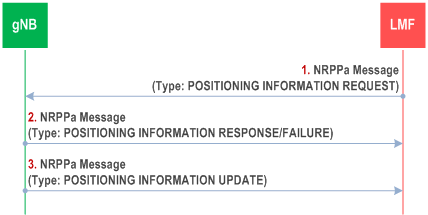
Step 1.
Figure 8.13.3.2.1-2 shows the TRP Information Exchange operation from the gNB to the LMF for the UL-TDOA positioning method.
The LMF sends a NRPPa message POSITIONING INFORMATION REQUEST to the serving gNB of the target UE to request UE SRS configuration information. If the message includes the Requested UL-SRS Transmission Characteristics as listed in Table 8.13.2.3-1, the gNB should take this information into account when configuring UL-SRS transmissions for the UE.
Step 2.
The serving gNB determines the UE SRS configuration to be allocated for the UE and sends NRPPa message POSITIONING INFORMATION RESPONSE to the LMF that includes the UE SRS configuration defined in Table 8.13.2.1-1. If the serving gNB is not able to provide the requested information, it returns a failure message indicating the cause of the failure.
Step 3.
If a change has occurred in the UE SRS configuration during the UE SRS time duration requested at step 1, the gNB sends a POSITIONING INFORMATION UPDATE message to the LMF. This message contains, in the case of a change in UE SRS configuration parameters, the UE SRS configuration information for all cells with UE SRS configured, or an update in SRS transmission status.
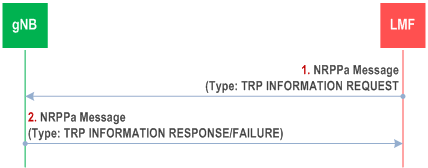
Step 1.
The LMF determines that certain TRP configuration information is desired (e.g., as part of a periodic update or as triggered by OAM) and sends an NRPPa TRP INFORMATION REQUEST message to the gNB. This request includes an indication of which specific TRP configuration information is requested.
Step 2.
The gNB provides the requested TRP information in an NRPPa TRP INFORMATION RESPONSE message, if available at the gNB. If the gNB is not able to provide any information, it returns an TRP INFORMATION FAILURE message indicating the cause of the failure.
8.13.3.3 Location Information Transfer/Assistance Data Transfer Procedure p. 155
The purpose of this procedure is to enable the LMF to request position measurements from a gNB for position calculation of the UE and also provide necessary assistance data to the gNB.
Figure 8.13.3.3-1 shows the messaging between the LMF and the gNB to perform this procedure.
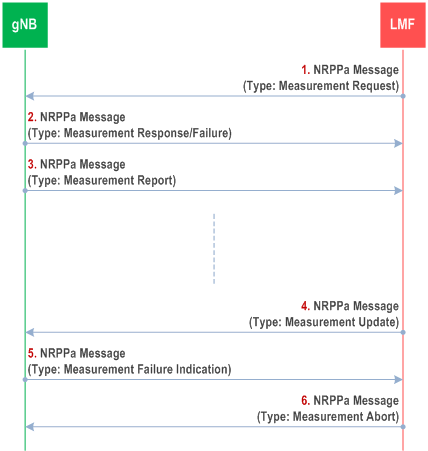
Step 1.
The LMF sends a NRPPa message to the selected gNB to request UL-TDOA measurement information. The message includes any information required for the gNB to perform the measurements as defined in Table 8.13.2.3-2.
Step 2.
If the report characteristics in step 1 is set to "on demand", the gNB obtains the requested UL-TDOA measurements and returns them in a Measurement Response message to the LMF. The Measurement Response message includes the obtained UL-TDOA measurements as defined in Table 8.13.2.2-1.
If the report characteristics in step 1 is set to "periodic", the gNB replies with a Measurement Response message without including any measurements in the message. The gNB then periodically initiates the Measurement Report procedure in step 3 for the UL-TDOA measurements, with the requested reporting periodicity.
If the gNB is not able to accept the Measurement Request message in step 1, the gNB returns a failure message indicating the cause of the failure.
Step 3.
The gNB periodically provides the UL-TDOA measurements as defined in Table 8.13.2.2-1 to the LMF if that was requested at step 1.
Step 4.
At any time after step 2, the LMF may send a Measurement Update message to the gNB providing updated information required for the gNB to perform the UL-TDOA measurements as defined in Table 8.13.2.3-2. Upon receiving the message, the gNB overwrites the previously received measurement configuration information.
Step 5.
If the previously requested UL-TDOA measurements can no longer be reported, the gNB notifies the LMF by sending a Measurement Failure Indication message.
Step 6.
When the LMF wants to abort an ongoing UL-TDOA measurement it sends a Measurement Abort message to the gNB.
8.13.3.3a Positioning Activation/Deactivation Procedure p. 156
The purpose of this procedure is to enable the LMF to request activation and deactivation of UL-SRS transmission of the target UE.
Figure 8.13.3.3a-1 shows the messaging between the LMF and the gNB to perform this procedure.
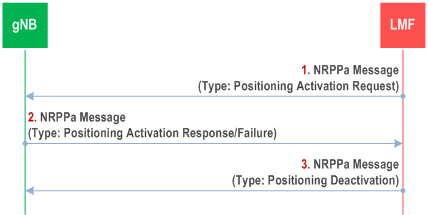
Step 1.
The LMF sends the NRPPa Positioning Activation Request message to the serving gNB of the target UE to request UL-SRS activation for the target UE. For a semi-persistent UL-SRS, the message includes an indication of an UL-SRS resource set to be activated and may include information that indicates the spatial relation for the semi-persistent UL-SRS resource to be activated, as listed in Table 8.13.2.3-3. For an aperiodic UL-SRS, the message may include aperiodic SRS Resource trigger list to indicate the UL-SRS resource to be activated.
Step 2.
For semi-persistent UL-SRS, the serving gNB may then activate the configured semi-persistent UL-SRS resource sets by sending the SP Positioning SRS Activation/Deactivation MAC CE command as specified in TS 38.321. For aperiodic UL-SRS, the serving gNB may then activate the configured aperiodic UL-SRS resource sets by sending the DCI as specified in TS 38.212.
If the UL-SRS has been successfully activated as requested in step 1, the gNB sends the NRPPa Positioning Activation Response message to the LMF. If the serving gNB is not able to fulfil the request from step 1, it returns the Positioning Activation Failure message indicating the cause of the failure. The serving gNB may include a system frame number and a slot number in the NRPPa Positioning Activation Response message to the LMF.
Step 3.
If a previously activated UL-SRS should be deactivated, or the UL-SRS transmission should be released, the LMF sends the NRPPa Positioning Deactivation message to the serving gNB of the target device to request deactivation of UL-SRS resource sets, or release all the UL-SRS resources. This message includes an indication of the UL-SRS resource set to be deactivated, or an indication of releasing all UL-SRS resources.
8.13.3.4 Sequence of Procedure for UL-TDOA positioning p. 156
Figure 8.13.3.4-1 shows the messaging between the LMF, the gNBs and the UE to perform UL-TDOA procedure.
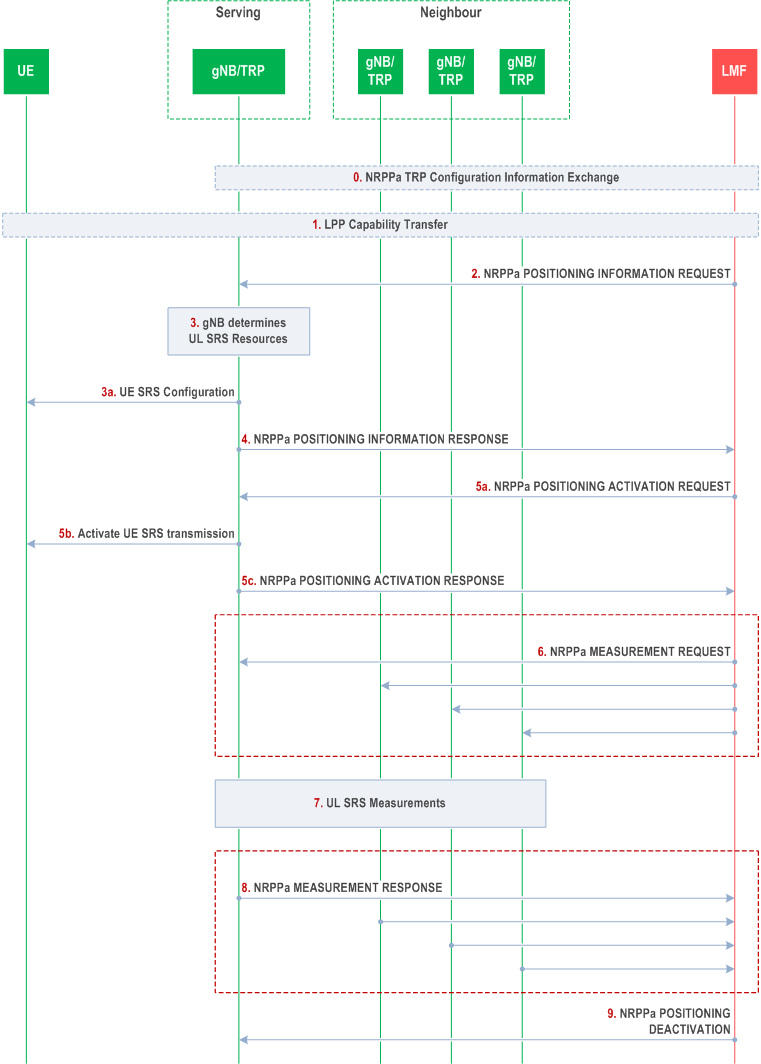
Step 0.
The LMF may use the procedure in Figure 8.13.3.2.1-2 to obtain the TRP information required for UL-TDOA positioning.
Step 1.
The LMF may request the positioning capabilities of the target device using the LPP Capability Transfer procedure as described in clause 8.13.3.1.
Step 2.
The LMF sends a NRPPa POSITIONING INFORMATION REQUEST message to the serving gNB to request UL-SRS configuration information for the target device as described in Figure 8.13.3.2.1-1.
Step 3.
The serving gNB determines the resources available for UL-SRS and configures the target device with the UL-SRS resource sets at step 3a.
Step 4.
The serving gNB provides the UL information to the LMF in a NRPPa POSITIONING INFORMATION RESPONSE message.
Step 5.
In the case of semi-persistent or aperiodic SRS, the LMF may request activation of UE SRS transmission by sending the NRPPa Positioning Activation Request message to the serving gNB of the target device as described in clause 8.13.3.3a. The gNB then activates the UL-SRS transmission and sends the NRPPa Positioning Activation Response message. The target device begins the UL-SRS transmission according to the time domain behavior of UL-SRS resource configuration.
Step 6.
The LMF provides the UL-SRS configuration to the selected gNBs in a NRPPa MEASUREMENT REQUEST message as described in clause 8.13.3.3. The message includes all information required to enable the gNBs/TRPs to perform the UL measurements.
Step 7.
Each gNB configured at step 6 measures the UL-SRS transmissions from the target device.
Step 8.
Each gNB reports the UL-SRS measurements to the LMF in a NRPPa Measurement Response message as described in clause 8.13.3.3.
Step 9.
The LMF sends a NRPPa POSITIONING DEACTIVATION message to the serving gNB as described in clause 8.13.3.3a.